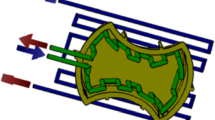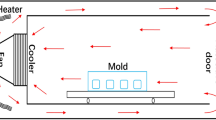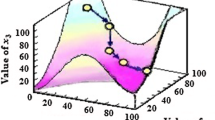Abstract
The cooling circuit should be properly designed for maximum part quality and shortest cycle time. The best way to insure the part quality in terms of cooling circuit is to design an optimum cooling circuit in the part design step. It is desirable to keep the optimum cooling circuit as intact as possible even in the mold design step. In this work, we proposed a new way to install cooling channels and baffle tubes in a mold for large automotive parts such as bumpers and instrument panels. Instead of conventional gradient method, a surrogate model method was used to optimize the cooling circuit for minimizing the temperature deviation over the part. As the surrogate model a response surface of quadratic form was applied. To supply the sampling points to the regression, the face-centered central composite design (FCCD) and the Box-Behnken design (BBD) were tried, and FCCD produced a slight better result. The temperature distribution by the optimized cooling circuit showed a good agreement with the normal distribution. The whole optimization process was done in a proper amount of running time, which means the optimizer can be utilized as a design tool in the part design step for the automatic generation of cooling circuit. The optimized result showed sufficiently low temperature deviation over the part.
Similar content being viewed by others
Abbreviations
- T i :
-
part temperature of an element (the arithmetic means of the upper and the lower surface temperatures)
- s :
-
standard deviation of part temperatures
- N :
-
the number of all finite elements in a product
References
Koresawa, H. and Suzuki, H., “Autonomous arrangement of cooling channels layout in injection molding,” Proceedings of 1999 annual technological conference of Society of Plastics Engineers, pp. 1073–1077, 1999.
Koresawa, H. and Suzuki, H., “Autonomous arrangement of cooling channels layout in injection molding,” Proceedings of 2000 annual technological conference of Society of Plastics Engineers, pp. 932–936, 2000.
Menges, G., Michaeli, W. and Mohren, P., “How to make injection molds,” Hanser Gardner Publications, pp. 293–303, 1993.
Chang, H. K., Jung, H. W., Lee, Y. J. and Rhee, B. O., “A Study on automatic optimization of cooling circuit design in injection mold,” Proceedings of 2007 Fall Conference of Korean Society for Technology of Plasticity, pp. 262–265, 2007.
Montgomery, D. C., “Design and analysis of experiments,” John Wiley & Sons, pp. 427–435, 2005.
Zarkadas, D. M. and Xanthos, M., “Prediction of cooling time in injection molding,” Advances in Polymer Technology, Vol. 22, No. 3, pp. 188–208, 2003.
Author information
Authors and Affiliations
Corresponding author
Rights and permissions
About this article
Cite this article
Rhee, BO., Park, CS., Chang, HK. et al. Automatic generation of optimum cooling circuit for large injection molded parts. Int. J. Precis. Eng. Manuf. 11, 439–444 (2010). https://doi.org/10.1007/s12541-010-0050-z
Received:
Accepted:
Published:
Issue Date:
DOI: https://doi.org/10.1007/s12541-010-0050-z




